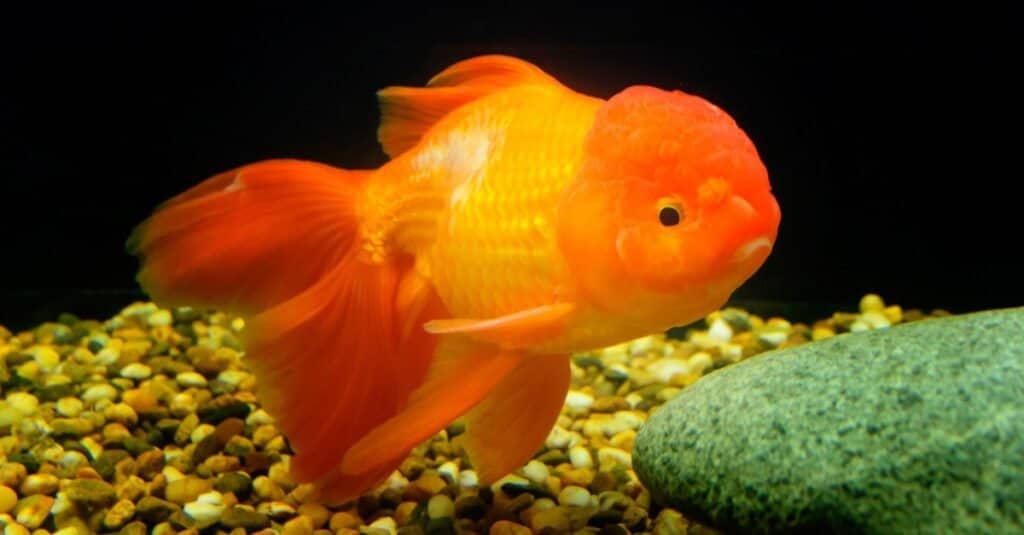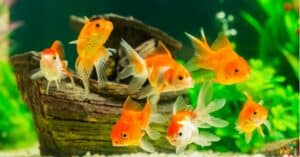Goldfish are the most popular pets in the world. For a better context, people buy more goldfish than dogs annually. About 480 million of them are sold every year. When most people think of a goldfish, they immediately picture a fishbowl sitting on the counter with a small goldfish swimming in it. They couldn’t be more wrong. In fact, you’ll be shocked to discover the size of the world’s largest goldfish on record.
Towards the end of November 2022, the news of a historic goldfish catch grabbed headlines worldwide. The gigantic orange catch was record-breaking not just because of the size of the fish but also because it had largely evaded fishermen for about two decades. This post covers all you need to know about this goldfish.”
Discovery — Where It Was Found

The biggest goldfish was caught at the Bluewater Lakes.
©dien/Shutterstock.com
The world’s largest goldfish, nicknamed “The Carrot” online, was caught at the popular Bluewater Lakes. Bluewater is located within the Champagne-Ardennes region in France. Bluewater Lakes is one of the most famous fisheries in the world that allow anglers to fish privately. The spot is well-known for its massive catch, with fish weighing as much as 70 or 90 pounds. The fishery manager, Jason Cowley, explained that they put the fish in the lake over twenty years ago.
The unique goldfish rarely made an appearance and managed to evade anglers for quite a long time. It continued to grow, and its rich orange color makes it the most distinctive fish in the lake. The massive goldfish is a hybrid leather carp and koi carp goldfish. At 67 pounds, it has shattered all previous records and now holds the title for the world’s largest goldfish ever caught. Bluewater Lakes reported that the unique fish was in good condition, and it may live for as much as 15 years, growing even bigger.
Who Caught the Largest Goldfish?
A UK angler, simply identified as Andy Hackett, caught this one-of-a-kind goldfish. Besides the fact that Hackett is a 42-year-old company manager from Kidderminster in Worchestire, we do not know much about him. Hackett always knew the Carrot was at Bluewater Lakes in France. Although he was determined to catch the fish, Hackett was not certain he would until he did.
How the World’s Largest Goldfish Was Caught
According to a report by the Daily Mail, Hackett believes his record-breaking catch was by sheer luck and not necessarily brilliant fishing skills. Hackett stated that he knew the fish was big the moment it caught on the line. It took twenty-five minutes for him to reel it in because of its sheer size, and then when the fish came up about 40 yards to the surface, Hackett noticed it was orange. He did not know how massive the catch was until he pulled it out of the water. He landed the prized fish on November 3, 2022. After taking pictures of the fish, Hackett released it back into the water and celebrated with friends.
How Big Was the World’s Largest Goldfish?
This giant goldfish weighed a staggering 67 pounds. Although it is still not the biggest fish ever caught at Bluewater Lakes, this is still a stunning size, especially for a goldfish. The Carrot goldfish is thirty pounds bigger than the fish Jason Fugate, a Minnesota Fisherman, caught in Brainerd lake in 2019. Fugate caught a giant orange bigmouth buffalo fish that weighed 33.1 pounds and was about 38 inches long. This particular fish was even older than Carrot the goldfish, with an estimated age of about 100 years.
The Carrot is also up to thirty pounds larger than the bright orange massive koi carp caught in 2010 by Raphael Biagini in France. It was viewed back then as one of the biggest catches of its kind in the wild. It is safe to say that the recent catch of the Carrot has surpassed both records.
How Big Can A Goldfish Get?

Goldfishes grow to an average maximum size of about 0.06 pounds.
©iStock.com/Foto_by_M
In a standard home tank, you should not worry about your goldfish growing to a nightmarish size. Pet goldfish require diets rich in protein and minerals to grow big. But even with the best food, they probably won’t grow into giants. They need a lot of space to grow into big sizes. In a tank, goldfishes grow to an average maximum size of about 0.06 pounds and a length of about one to two inches. That is several times smaller than they tend to grow in the wild. The record for the longest pet goldfish is about 18.7 inches, according to the Guinness World Record.
The truth is that many humans would rather maintain the small size of their goldfish as it is great for aesthetics. Pet varieties are bred specifically for that purpose and cannot grow as big as the species in the wild.
At the end of the day, goldfish grow big simply as a result of their environment and the kinds of food they get. Goldfish in the wild are surrounded by numerous food sources, few predators, and lesser competition. Therefore, it is no surprise that they tend to grow so big, especially if they have been left alone for a decade or more. A goldfish in a tank or bowl will grow according to the conditions around it.
What You Should Know about Goldfish
The catch of an enormous goldfish is always applaudable. It is not just a testament to the fisherman’s impressive skill but gives us more insight into how wild nature can grow, especially when animals are allowed to thrive undisturbed.
The remarkable catches of Biagini, Hackett, and Fugate have proven that when goldfishes are left to thrive, they can grow to mind-blowing sizes, and their lifespan can increase exponentially — even up to 40 years. Apart from the considerable size difference, enormous-sized goldfishes are not very different from their conventionally-sized counterparts. They have just as much intelligence and share the same features that have fascinated scientists for decades.
The Carrot is a goldfish from the Carassius aureus carp species that has been known to bloom into jaw-dropping sizes. In the case of the Carrot goldfish and the other fish species discovered in 2010 and 2019, these fishes were all left in the waters for more than 15 years.
Of course, this does not mean you should throw your pet goldfish in a public waterway, river, or lake. In fact, scientists warn against this as pet goldfish can be problematic for the aquatic ecosystem wherever they thrive. The small fish tends to uproot bottom sediments in the water, which contributes to poor water quality. These environmental concerns are worsened by the fact that they can grow into behemoths in the wild when they are left with enough resources and very few predators. They can outcompete native fishes and litter waters with their excreta.
Conclusion
It is still unknown whether anyone would beat Hackett’s remarkable catch anytime soon. However, with the scientifically proven growth rate of goldfish in the wild and the universal reality that all records are eventually surpassed, it may only be a matter of time before another monumental goldfish is found. And while we will be here to savor the thrill, it is imperative to adhere to scientists’ warnings about not tossing goldfish into the ocean.
Up Next
- World Record Alligator Gar: Discover the Largest Alligator Gar Ever Caught
- World Record Catfish: Discover the Largest Catfish Ever Caught
- Discover The World’s Largest Manta-Ray Ever Recorded
The photo featured at the top of this post is © Yana Art/Shutterstock.com
Sources
- Washington Post (1970) washingtonpost.com/world/2022/11/22/giant-goldfish-caught-france/ / Accessed December 10, 2022
- (1970)
Thank you for reading! Have some feedback for us? Contact the AZ Animals editorial team.






